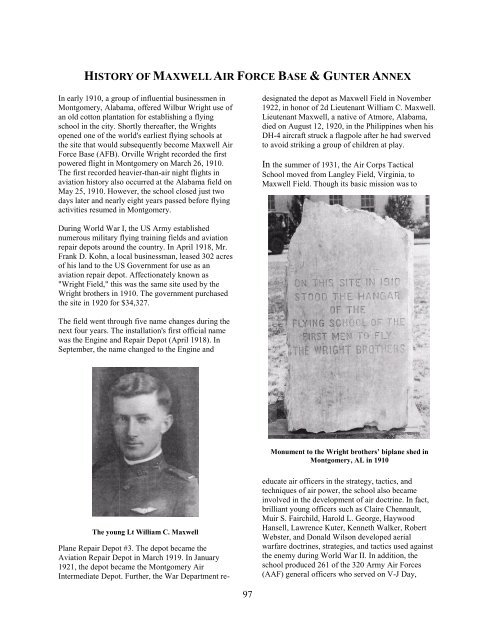Air University Educational Digest - 2010 (pdf ... - The Air University
Air University Educational Digest - 2010 (pdf ... - The Air University
Air University Educational Digest - 2010 (pdf ... - The Air University
You also want an ePaper? Increase the reach of your titles
YUMPU automatically turns print PDFs into web optimized ePapers that Google loves.
HISTORY OF MAXWELL AIR FORCE BASE & GUNTER ANNEX<br />
In early 1910, a group of influential businessmen in<br />
Montgomery, Alabama, offered Wilbur Wright use of<br />
an old cotton plantation for establishing a flying<br />
school in the city. Shortly thereafter, the Wrights<br />
opened one of the world's earliest flying schools at<br />
the site that would subsequently become Maxwell <strong>Air</strong><br />
Force Base (AFB). Orville Wright recorded the first<br />
powered flight in Montgomery on March 26, 1910.<br />
<strong>The</strong> first recorded heavier-than-air night flights in<br />
aviation history also occurred at the Alabama field on<br />
May 25, 1910. However, the school closed just two<br />
days later and nearly eight years passed before flying<br />
activities resumed in Montgomery.<br />
During World War I, the US Army established<br />
numerous military flying training fields and aviation<br />
repair depots around the country. In April 1918, Mr.<br />
Frank D. Kohn, a local businessman, leased 302 acres<br />
of his land to the US Government for use as an<br />
aviation repair depot. Affectionately known as<br />
"Wright Field," this was the same site used by the<br />
Wright brothers in 1910. <strong>The</strong> government purchased<br />
the site in 1920 for $34,327.<br />
<strong>The</strong> field went through five name changes during the<br />
next four years. <strong>The</strong> installation's first official name<br />
was the Engine and Repair Depot (April 1918). In<br />
September, the name changed to the Engine and<br />
<strong>The</strong> young Lt William C. Maxwell<br />
Plane Repair Depot #3. <strong>The</strong> depot became the<br />
Aviation Repair Depot in March 1919. In January<br />
1921, the depot became the Montgomery <strong>Air</strong><br />
Intermediate Depot. Further, the War Department re-<br />
97<br />
designated the depot as Maxwell Field in November<br />
1922, in honor of 2d Lieutenant William C. Maxwell.<br />
Lieutenant Maxwell, a native of Atmore, Alabama,<br />
died on August 12, 1920, in the Philippines when his<br />
DH-4 aircraft struck a flagpole after he had swerved<br />
to avoid striking a group of children at play.<br />
In the summer of 1931, the <strong>Air</strong> Corps Tactical<br />
School moved from Langley Field, Virginia, to<br />
Maxwell Field. Though its basic mission was to<br />
Monument to the Wright brothers’ biplane shed in<br />
Montgomery, AL in 1910<br />
educate air officers in the strategy, tactics, and<br />
techniques of air power, the school also became<br />
involved in the development of air doctrine. In fact,<br />
brilliant young officers such as Claire Chennault,<br />
Muir S. Fairchild, Harold L. George, Haywood<br />
Hansell, Lawrence Kuter, Kenneth Walker, Robert<br />
Webster, and Donald Wilson developed aerial<br />
warfare doctrines, strategies, and tactics used against<br />
the enemy during World War II. In addition, the<br />
school produced 261 of the 320 Army <strong>Air</strong> Forces<br />
(AAF) general officers who served on V-J Day,
















